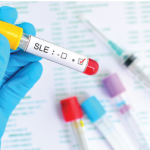Toll-like receptors (TLRs) appear to play an important role in the pathogenesis of fibrotic disorders including nephrogenic systemic fibrosis (NSF) and systemic sclerosis. This discovery may open up a new area of investigation: the triggering of the fibrotic process by an environmental agent.
One of the major causes of NSF is the exposure of patients with renal insufficiency to gadolinium-based contrast agents (GdBCAs) such as Omniscan. GdBCAs are used to enhance magnetic resonance imaging. GdBCAs contain a single Gd3+ ion that has increased solubility and decreased toxicity due to its being complexed to either a linear or a macrocyclic chelate.
Many studies have shown that GdBCAs induce potent metabolic changes in cells, including increased hyaluronan and collagen production by fibroblasts, increased production of proinflammatory cytokines by peripheral blood mononuclear cells (PBMCs) and macrophages, as well as increased differentiation of PBMCs into fibrocytes. Previous studies have also shown that Omniscan upregulates several innate immunity pathways in normal differentiated human macrophages.
While it has long been known that patients with renal insufficiency are vulnerable to GdBCA-induced NSF, the mechanism behind the pathogenesis has not been understood. A new study, published in the Journal of Immunology, provides the first thorough analysis of GdBCA stimulation of the innate immune system.1
According to corresponding author Sergio A. Jimenez, MD, codirector of the Jefferson Institute of Molecular Medicine at Thomas Jefferson University in Philadelphia, the results underscore “the idea that exogenous agents can trigger a fibrotic reaction that looks like scleroderma.” He explains that there have been several documented cases where an environmental contaminant triggered a fibrotic process. In the case of eosinophilia myalgia syndrome in the United States and toxic oil syndrome in Spain, the mechanism behind the progressive fibrosis was never understood.
TLRs have recently been proposed to play a role in innate immunity as well as the development of various fibrotic disorders such as systemic sclerosis and pulmonary fibrosis. Researchers have now discovered that both Omniscan and gadodiamide induce normal human differentiated macrophages to produce multiple profibrotic and proinflammatory cytokines, chemokines, and growth factors via signaling through both TLR4 and TLR7. The effect of Gd compounds on fibroblasts may also be due to signaling via TLR4 since fibroblasts also express TLR4 at on the cell surface.
The authors had previously shown that exposure of normal differentiated human macrophages to Omniscan upregulated IFN-responsive genes as well as activated NF-ĸB. They began their current study by investigating the ability of GdBCAs to induce NF-ĸB activation of human embryonic kidney (HEK)293 cells expressing multiple human TLRs and two human NOD-like receptors (NLRs).

